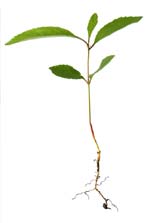BIOLOGY
by Miller & Levine
[complete Table of Contents]

|
Use the pull-down menu to jump to any of the Book's 40 Chapters: |
Additional Resources:

All
about Plant Hormones
A web site from the UK
Plant
Hormones
from Ohio State University
![]() Chapter 25
Chapter 25 ![]()
Plant Responses and Adaptation
In this chapter, students will read about the effects of the four major types of plant hormones (auxins, cytokinins, gibberellins, and ethylene); plant responses such as tropisms, photoperiodism, and responses to seasonal changes; and mechanisms of adaptation to extreme environments and attacks by insect predators. The links below lead to additional resources to help you with this chapter. These include Hot Links to Web sites related to the topics in this chapter, the Take It to the Net activities referred to in your textbook, a Self-Test you can use to test your knowledge of this chapter, and Teaching Links that instructors may find useful for their students.
| Hot Links | |
| Take it to the Net | Teaching Links |
What are Web Codes? |
Web
Codes for Chapter 25: |
![]()
Section
25-1: Hormones and Plant Growth
![]() Plant hormones
are chemical substances that control a plant's patterns of growth and
development and the plant's responses to environmental conditions.
Plant hormones
are chemical substances that control a plant's patterns of growth and
development and the plant's responses to environmental conditions.
 Auxins are produced in the apical meristem
and are transported downward into the rest of the plant. They stimulate
cell elongation.
Auxins are produced in the apical meristem
and are transported downward into the rest of the plant. They stimulate
cell elongation.
 Cytokinins are produced in growing roots
and in developing fruits and seeds. They stimulate cell division and the
growth of lateral buds, and cause dormant seeds to sprout.
Cytokinins are produced in growing roots
and in developing fruits and seeds. They stimulate cell division and the
growth of lateral buds, and cause dormant seeds to sprout.
 Gibberellins produce dramatic increases
in size, particularly in stems and fruit.
Gibberellins produce dramatic increases
in size, particularly in stems and fruit.
In response to auxins, fruit tissues release small amounts of the hormone
ethylene.  Ethylene then stimulates fruits
to ripen.
Ethylene then stimulates fruits
to ripen.
Section
25-2: Plant Responses
 Plant tropisms include gravitropism,
phototropism, and thigmotropism. Each of these responses demonstrates
the ability of plants to respond effectively to conditions in which they
live.
Plant tropisms include gravitropism,
phototropism, and thigmotropism. Each of these responses demonstrates
the ability of plants to respond effectively to conditions in which they
live.
 Photoperiodism in plants is responsible
for the timing of seasonal activities such as flowering and growth.
Photoperiodism in plants is responsible
for the timing of seasonal activities such as flowering and growth.
 As cold weather approaches, deciduous
plants turn off photosynthetic pathways, transport materials from leaves
to roots, and seal leaves off from the rest of the plant.
As cold weather approaches, deciduous
plants turn off photosynthetic pathways, transport materials from leaves
to roots, and seal leaves off from the rest of the plant.
Section
25-3: Plant Adaptations
 To take in sufficient oxygen, many aquatic
plants have tissues with large air-filled spaces through which oxygen
can diffuse.
To take in sufficient oxygen, many aquatic
plants have tissues with large air-filled spaces through which oxygen
can diffuse.
 Plant adaptations to a desert climate
include extensive roots, reduced leaves, and thick stems that can store
water.
Plant adaptations to a desert climate
include extensive roots, reduced leaves, and thick stems that can store
water.
 Plants that have specialized features
for obtaining nutrients include carnivorous plants and parasites.
Plants that have specialized features
for obtaining nutrients include carnivorous plants and parasites.
 Many plants defend themselves against
insect attack by manufacturing compounds that have powerful effects on
animals.
Many plants defend themselves against
insect attack by manufacturing compounds that have powerful effects on
animals.